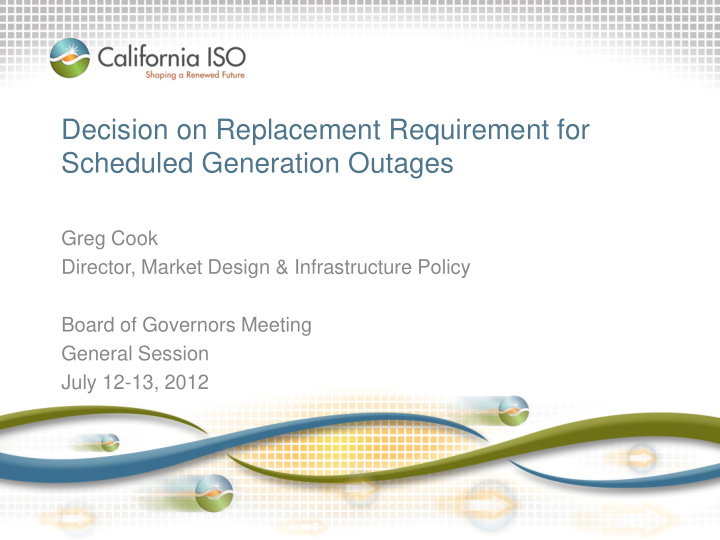



Decision on Replacement Requirement for Scheduled Generation Outages Greg Cook Director, Market Design & Infrastructure Policy Board of Governors Meeting General Session July 12-13, 2012
Resource adequacy program ensures that sufficient generation is offered into the ISO market to maintain grid reliability. • Load serving entities required to secure capacity to meet load requirements plus planning reserve margin • Historically, resource adequacy program has included a replacement rule administered by CPUC – Provides some assurance that capacity will be available and not on extended maintenance outages – CPUC found that replacement requirement rules should be administered by ISO Page 2
Replacement requirement proposal provides greater certainty for availability of resource adequacy resources. Proposal consists of six elements: 1. Replacement requirement in tariff 2. Timing of monthly resource adequacy showings 3. Short-term opportunity outages 4. “Non-designated” resource adequacy capacity 5. Short-term replacement resource adequacy capacity 6. Electronic bulletin board Page 3
Proposal ensures 115% planning reserve margin through process for replacement of capacity unavailable due to scheduled outages. No planned RA outages without substitution ISO analysis Cure period Short-term RA capacity Short-term opportunity outages Un-replaced deemed forced Feedback to Deadline to cure Showings and Operating participants deficiencies supply plans due month t-45 t-25 t-10 t-0 t+31 Page 4
Short-term opportunity outages provide resource adequacy resources the ability to perform maintenance during the operating month. • Requested after t-10 • Requested up to 72 hours prior to requested start of the outage • During non-peak hours • Subject to ISO reliability assessments Page 5
If a load serving entity fails to replace capacity identified by the ISO assessment, the ISO will procure short-term replacement capacity. • Short-term replacement capacity will be procured – When identified replacement needs are not resolved by the end of the cure period at t-10 • ISO will pay administrative price – pro rata capacity procurement mechanism rate • Costs of the procurement allocated to the load serving entity that failed to meet a requirement for replacement capacity – Provides incentive for resource adequacy showings that reflect available capacity Page 6
Electronic bulletin board will be provided to facilitate transactions for replacement capacity. • Online forum for market participants to identify capacity available for substitution • Facilitates bilateral negotiations for replacement capacity – Through the cure period – After t-10, through the operating month Page 7
Stakeholders generally support (or do not oppose) the proposal. However some concerns remain: • Some stakeholders (AReM, GenOn, PG&E) prefer adopting current CPUC rules or do-nothing approach • Moving timeline up for resource adequacy showings needs to be coordinated with CPUC and CEC processes • Generators request short-term outages be available with less notice than 72 hours Page 8
Management recommends the Board approve the proposal: • Provides greater certainty for resource availability compared to current CPUC rules – Ensures 115% planning reserve margin going into each month • Provides incentives for resources to schedule planned outages in advance • Includes provisions for unforeseen maintenance outages during the operating month • Includes provisions to facilitate transactions for replacement capacity Page 9
Recommend
More recommend